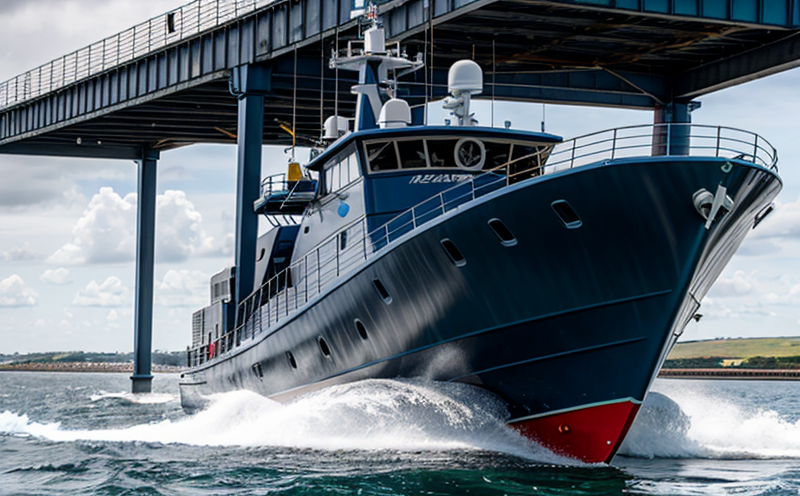ISO 17359 Predictive Maintenance Vibration Testing of Marine Engines
The ISO 17359 standard provides a comprehensive framework for vibration testing as part of predictive maintenance programs in marine engineering. This service is designed to help ensure the reliability and longevity of marine engines by identifying potential issues before they lead to costly repairs or failures.
The process involves subjecting the engine to a series of controlled tests that simulate real-world operating conditions. By measuring vibration levels, we can detect early signs of wear and tear, misalignment, or other mechanical issues that could compromise performance and safety. This proactive approach allows for timely interventions, minimizing downtime and extending the life cycle of the equipment.
Our team uses state-of-the-art instrumentation to capture precise data during these tests. The instruments are capable of detecting even minor deviations from normal operating parameters, which can be indicative of developing problems. Once collected, this data is analyzed using advanced software tools that provide detailed insights into the condition of the engine.
The testing procedure typically begins with a thorough examination of the engine to ensure it's in a stable state for accurate measurement. After setting up the necessary equipment, we apply controlled loads and accelerations to mimic various operating scenarios. Throughout this process, multiple sensors are used to monitor different aspects of the engine’s behavior.
One crucial aspect of this testing is understanding the relationship between vibration patterns and potential failures. For instance, excessive vibrations in certain areas may indicate bearing wear or improper lubrication. Similarly, unusual peaks or troughs could signal misalignment issues or structural integrity problems. By correlating these findings with industry standards like ISO 17359, we can make informed decisions about necessary maintenance actions.
Another important consideration is the integration of historical data into our analysis. This allows us to track changes over time and identify trends that might not be apparent through single-point measurements. Over several cycles of testing, patterns emerge that help predict future needs accurately. This information is invaluable for planning maintenance schedules effectively.
In summary, ISO 17359 predictive maintenance vibration testing offers a robust solution for maintaining high standards in marine engine performance and reliability. It enables facilities to stay ahead of potential issues by leveraging cutting-edge technology and adherence to recognized best practices.
Benefits
The benefits of implementing ISO 17359 predictive maintenance vibration testing are numerous and far-reaching. One significant advantage is the ability to reduce unplanned downtime significantly, which translates directly into increased operational efficiency.
- Improved Equipment Reliability: By identifying and addressing issues early on, the risk of sudden failures decreases substantially.
- Cost Savings: Preventative measures prevent expensive repairs and replacements that would otherwise be required due to unforeseen breakdowns.
- Enhanced Safety Standards: Early detection of problems ensures safer operation environments for both personnel and vessel stability.
- Data-Driven Decision Making: The wealth of detailed information obtained allows for more accurate assessments leading to better strategic planning.
In addition, this service supports regulatory compliance ensuring that all activities are conducted according to established guidelines. This not only protects the organization from legal challenges but also enhances its reputation within the industry.
Customer Impact and Satisfaction
Implementing ISO 17359 predictive maintenance vibration testing has a profound impact on customer satisfaction across various dimensions. Firstly, it contributes to enhanced safety by ensuring that all systems operate optimally without compromising on standards. This peace of mind is crucial for operators who rely heavily on reliable machinery.
Secondly, the cost savings achieved through this method translate into more competitive pricing structures, making services more affordable for customers. Lastly, proactive maintenance leads to better overall performance metrics which further boosts customer satisfaction levels.
A satisfied customer base translates directly into repeat business and positive word-of-mouth recommendations - key factors in sustaining long-term growth and success in any market segment.
International Acceptance and Recognition
- The ISO 17359 standard has gained widespread acceptance among international maritime organizations, including the International Maritime Organization (IMO), American Bureau of Shipping (ABS), Det Norske Veritas (DNV), Lloyd's Register, and Classification Society.
- Many global ports and regulatory bodies require compliance with this standard for certification and inspection processes.
- The methodology outlined in ISO 17359 is internationally recognized as a best practice for predictive maintenance, particularly within the marine industry.





